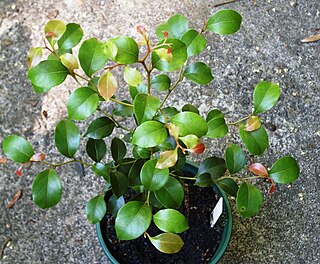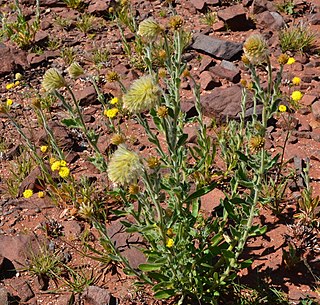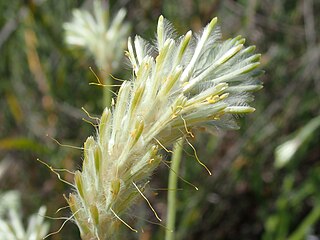
Banksia audax is a species of shrub that is endemic to Western Australia. It has fissured, grey bark, woolly stems, hairy, serrated leaves and golden orange flower spikes.

Ptilotus is a genus of approximately 125 species of flowering plants in the family Amaranthaceae, and is endemic to Australia, apart from Ptilotus conicus that also occurs in Malesia. Plants in the genus Ptilotus are annual or perennial herbs or shrubs with usually hairy spikes of compact spherical, oval or cylindrical flowers.

Cryptocarya williwilliana, commonly known as small-leaved laurel, is a species of flowering plant in the laurel family and is endemic to near Kempsey in northern New South Wales. It is a tree or shrub with egg-shaped or lance-shaped leaves, the flowers creamy-green and perfumed, and the fruit a spherical to elliptic, black drupe.

Ptilotus exaltatus, more commonly known as pink mulla mulla, is an erect annual herb endemic to large parts of arid and semi-arid Australia. It grows throughout most areas of Australia except the Nullarbor Plain, occurring geographically above a line drawn from Perth to Esperance. The species was first observed and described in 1810, and comprehensively catalogued in 1971.

Ptilotus clementii, commonly known as tassel top, is a native Australian annual herb growing to between 0.3 and 1 metre high. Nodding, green flower spikes are produced between March and November in the species' native range.

Ptilotus nobilis, commonly known as yellow tails, is an annual or short-lived perennial herb of the family Amaranthaceae. It is found in arid regions of South Australia, southern and eastern Northern Territory, western Queensland and western New South Wales.

Petrophile misturata is a species of flowering plant in the family Proteaceae and is endemic to southwestern Western Australia. It is a shrub with simple and pinnate, needle-shaped leaves and spherical heads of hairy, dull yellow flowers.

Ptilotus pyramidatus, the pyramid mulla mulla, is a small white herb in the family Amaranthaceae.

Ptilotus polystachyus is a perennial herb in the Amaranthaceae family.

Ptilotus schwartzii is a grass-like plant in the Amaranthaceae family.

Ptilotus latifolius, the tangled mulla mulla, is a perennial herb that is native to Australia, which grows abundantly on sand dunes and stony plains. The key diagnostic features of this plant are its very stem bound, shrub like appearance with densely clustered white white flowers with pink tips when newly blossomed. Each stem is generally supported by one to two leaves and the stems have a fluffy textures as well as the flowers. The petiole is generally long in this species and spike bound.

Wilkiea pubescens is a species of flowering plant in the family Monimiaceae, and is endemic to north Queensland. It is a shrub or small tree with elliptic leaves and male and female flowers on separate plants. Male flowers have 6 tepals and 2 or 3 pairs of stamens and female flowers have 2 pairs of tepals and 15 to 30 carpels. The fruit is a purplish-black drupe.
Ptilotus actinocladus is a species of flowering plant in the family Amaranthaceae and is endemic to inland Western Australia. It is a prostrate annual herb with a central stem and radiating lateral stems, linear to lance-shaped stem leaves, pink spherical or cylindrical spikes of flowers with long, silky hairs, and four fertile stamens.

Ptilotus aervoides, commonly known as mat mulla mulla, is a species of flowering plant in the family Amaranthaceae and is endemic to western Australia. It is a prostrate, mat-forming annual or short-lived perennial herb, its stems densely hairy at first, egg-shaped to spatula-shaped stem leaves, dense spikes of hairy creamy-green flowers with two or three fertile stamens.
Ptilotus alexandri is a species of flowering plant in the family Amaranthaceae and is endemic to the far west of Western Australia. It is an erect, annual herb with spatula-shaped leaves, spikes of pink flowers and glossy black seeds.
Ptilotus andersonii is a species of flowering plant in the family Amaranthaceae and is endemic to a restricted area of Western Australia. It is a prostrate, hairy, perennial herb with a spatula-shaped to lance-shaped leaves at the base of the plant, lance-shaped cauline leaves, and pink, oval spikes of flowers with two fertile stamens.
Ptilotus angustifolius, commonly known as regal fox tails, is a species of flowering plant in the family Amaranthaceae and is endemic to South Australia. It is a low, bushy herb with a several stems, narrowly egg-shaped leaves at the base of the plant, oval, intensely fragrant spikes of purple flowers and cylindrical heads of many long, hairy fruits.

Ptilotus aphyllus is a species of flowering plant in the family Amaranthaceae and is endemic to the a small area of inland Western Australia. It is a leafless perennial, except when young, and spikes of purple flowers fading to pink and pale orange.

Ptilotus appendiculatus is a species of flowering plant in the family Amaranthaceae and is endemic to the north of Western Australia. It is a prostrate perennial herb with egg-shaped leaves and spikes of pink flowers.















